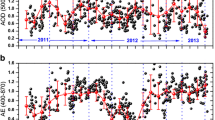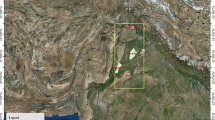Abstract
Every year during winter months (December–January) fog formation over Indo-Gangetic plains (IGP) of Indian region is believed to create numerous hazards. The present study addresses variations in aerosol optical properties, aerosol mass concentration and their impact on solar irradiance for pre-during-post fog conditions of December 2004 over IGP, India. Continuous measurements on aerosol optical depth (AOD), total aerosol mass concentration, black carbon (BC) aerosols, UVery and UVA were carried out for pre, during and post fog periods over study site of Allahabad, India, during December 2004 as a part of Aerosol Land Campaign-II conducted by Indian Space Research Organization (ISRO). High aerosol mass concentrations were observed during fog and post-fog periods. Accumulation mode particle loading was found to be high during pre-fog period and coarse mode particle loading was observed to be high during fog and post-fog periods. Considerable reduction in UVery and UVA irradiance was observed during fog period compared with pre and post-fog periods. Analysis of NOAA-HYSPLIT model runs suggested that enhanced biomass burning episodes down-wind to the study area increased the concentration of AOD and BC.









Similar content being viewed by others
References
Angstrom A (1964) The parameters of atmospheric turbidity. Tellus 16:64–75
Babu SS, Satheesh SK, Moorthy KK (2002) Aerosol radiative forcing due to enhanced black carbon at an urban site in India. Geophys Res Lett 29(18):1880. doi:10.1029/2002GL015826
Badarinath KVS, Latha KM, Kiran Chand TR, Reddy RR, Rama Gopal K, Reddy LSS, Narasimhulu K, Kumar KR (2007a) Black carbon aerosols and gaseous pollutants in an urban area in North India during a fog period. Atmos Res 85:209–216
Badarinath KVS, Kharol SK, Kaskaoutis DG, Kambezidis HD (2007b) Influence of atmospheric aerosols on solar spectral irradiance in an urban area. J Atmos Sol Terr Phys 69:589–599
Badarinath KVS, Kharol SK, Kaskaoutis DG, Kambezidis HD (2007c) Case study of a dust storm over Hyderabad area, India: its impact on solar radiation using satellite data and ground measurements. Sci Total Environ 384:316–332
Badarinath KVS, Kharol SK, Sharma AR, Roy PS (2009) Fog over Indo-Gangetic Plains—a study using multisatellite data and ground observations. IEEE-JSTARS 2(3):185–195
Bergot T, Guédalia D (1994) Numerical forecasting of radiation fog. Part 1: numerical model and sensitivity tests. Mon Weather Rev 122:1218–1230
Box MA, Deepak A (1979) Atmospheric corrections to solar radiometry. Appl Opt 12:1941–1949
Choudhury S, Rajpal H, Saraf AK, Panda S (2007) Mapping and forecasting of North Indian winter fog: an application of spatial technologies. Int J Remote Sens 28(16):3649–3663
Das SK, Jayaraman A, Mishra A (2008) Fog-induced variations in aerosol optical and physical properties over the Indo-Gangetic basin and impact to aerosol radiative forcing. Ann Geophys 26:1345–1354
Day DE, Malm WC (2001) Aerosol light scattering measurements as a function of relative humidity: a comparison between measurements made at three different sites. Atmos Environ 35:5169–5176
Day DE, Malm WC, Kreidenweis SM (2000) Aerosol light scattering measurements as a function of relative humidity. J Air Waste Manag Assoc 50:710–716
Draxler RR, Rolph GD (2003). HYSPLIT (Hybrid single-particle Lagrangian Integrated Trajectory) model. Report, Air Resour. Lab., NOAA, Silver, Spring, MD. http://www.arl.noaa.gov/ready/hysplit4.html
Ganguly D, Jayaraman A, Rajesh TA, Gadhavi H (2006) Wintertime aerosol properties during foggy and non-foggy days over urban center Delhi and their implications for shortwave radiative forcing. J Geophys Res 111:D15217. doi:10.1029/2005JD007029
Guazzotti SA (2003) Characterization of carbonaceous aerosols outflow from Indian and Arabia: biomass/bio-fuel burning and fossil fuel combustion. J Geophys Res 108(D15):4485. doi:10.1029/2002JD003277
Hänel G (1976) The properties of atmospheric aerosol particles as functions of relative humidity at thermodynamic equilibrium with surrounding moist air. In: Advances in geophysics, vol 19. Academic Press, New York, pp 73–188
Hess M, Koepke P, Schult I (1998) Optical properties of aerosols and clouds: the software package OPAC. Bull Am Meteorol Soc 79:831
Ichoku C, Chu DA, Mattoo S, Kaufman YJ, Remer LA, Tanré D, Slutsker I, Holben BN (2002) A spatio-temporal approach for global validation and analysis of MODIS aerosol products. Geophys Res Lett 29(12):Art. No. 1616, 1–4
Jayaraman A, Lubin D, Ramachandran S, Ramanathan V (1998) Direct observations of aerosol radiative forcing over the tropical Indian Ocean during the January–February, 1996 pre-INDOEX cruise. J Geophys Res 103:13827–13836
Jenamani RK (2007) Alarming rise in fog and pollution causing a fall in maximum temperature over Delhi. Curr Sci 93(3):314–322
Kaskaoutis DG, Kambezidis HD (2008) Comparison of the Ångström parameters retrieval in different spectral ranges with the use of different techniques. Meteorol Atmos Phys 99:233–246
Kulmala M, Laaksonen A, Charlson RJ, Korhonen P (1997) Clouds without supersaturation. Nature 388:336–337
Lillis D, Cruz CN, Collett J, Richards WL, Pandis SN (1999) Production and removal of aerosol in a polluted fog layer: model evaluation and fog effect on PM. Atmos Environ 33:4797–4816
Liousse C, Cachier H, Jennings SG (1993) Optical and thermal measurements of black carbon aerosol content in different environments: variation of the specific attenuation cross section, sigma. Atmos Environ 27A:1203–1211
McKinlay AF, Diffey BL (1987) A reference action spectrum for ultraviolet induced erythema in human skin. CIE J 6:17–22
Menon S, Hansen J, Nazarenko L, Luo Y (2002) Climate effects of black carbon aerosols in China and India. Science 297:2250–2253
Morys M, Mims FM III, Hagerup S, Anderson SE, Baker A, Kia J, Walkup T (2001) Design, calibration, and performance of MICROTOPS II handheld ozone monitor and sun photometer. J Geophys Res 106:14573–14582
Podgorny IA, Conant WC, Ramanathan V, Satheesh SK (2000) Aerosol modulation of atmospheric and surface solar heating rates over the Tropical Indian Ocean. Tellus 52:947–958
Prasad AK, Singh RP, Kafatos M (2006) Influence of coal based thermal power plants on aerosol optical properties in the Indo-Gangetic basin. Geophys Res Lett 33:L05805
Reagan JA, Thomason LW, Herman BM, Palmer JM (1986) Assessment of atmospheric limitations on the determination of the solar spectral constant from ground-based spectroradiometer measurements. IEEE Trans Geosci Remote Sens GE 24:258–266
Roberts GC, Artaxo P, Zhou J, Swietlicki E, Andreae MO (2002) Sensitivity of CCN spectra on chemical and physical properties of aerosol: a case study from the Amazon Basin. J Geophys Res 107(D20):8070. doi:10.1029/2001JD000583
Russell PB et al (1993) Pinatubo and pre-Pinatubo optical-depth spectra: Mauna Loa measurements, comparisons, inferred particle size distributions, radiative effects, and their relationship to lidar data. J Geophys Res 98:22969–22985
Satheesh SK, Ramanathan V, Holben BN, Krishna Moorthy K, Oeb N, Maring GH, Prospero JM, Savoie D (2002) Chemical, microphysical, and radiative effects of Indian Ocean Aerosols. J Geophys Res 107:4725–4733
Schmid B, Wehrli C (1995) Comparison of sun photometer calibration by use of the Langley technique and standard lamp. Appl Opt 34:4500–4512
Schuster GL, Dubovik O, Holben BN (2006) Angstrom exponent and bimodal aerosol size distributions. J Geophys Res 111:D07207. doi:101029/2005JD006328
Shaw GE (1976) Error analysis of multiwavelength sun photometry. Pure Appl Geophys 114:1–14
Tripathi SN, Dey S, Tare V, Satheesh SK (2005) Aerosol black carbon radiative forcing at an industrial city in northern India. Geophys Res Lett 32:L08802. doi:10.1029/2005GL022515
Tulsidas A, Mohapatra M (1998) Analysis and formation of fog over Bangalore airport. Mausam 49(1):35–142
Venkataraman C, Habib G, Eiguren-Fernandez A, Miguel AH, Friedlander SK (2005) Residential biofuels in South Asia: carbonaceous aerosol emissions and climate impacts. Science 307:1454–1456
Yuskiewicz BA, Orsini D, Stratmann F, Wendisch M, Wiedensohler A, Wobrock W, Schell D (1998) Changes in submicrometer particle distributions and light scattering during haze and fog events in a highly polluted environment. Beitr zur Phys der Atmos 71:33–45
Acknowledgments
The authors are grateful to Director, NRSC and Dy. Director (RS&GIS-AA), NRSC for their help and encouragement and to ISRO-GBP for funding support. The authors gratefully acknowledge the NOAA Air Resources Laboratory (ARL) for the provision of the HYSPLIT transport and dispersion model and/or READY website (http://www.arl.noaa.gov/ready.html) used in this publication. The NCEP re-analysis scientific team is also gratefully acknowledged for providing the meteorological fields.
Author information
Authors and Affiliations
Corresponding author
Rights and permissions
About this article
Cite this article
Badarinath, K.V.S., Kharol, S.K., Kiran Chand, T.R. et al. Characterization of aerosol optical depth, aerosol mass concentration, UV irradiance and black carbon aerosols over Indo-Gangetic plains, India, during fog period. Meteorol Atmos Phys 111, 65–73 (2011). https://doi.org/10.1007/s00703-010-0117-5
Received:
Accepted:
Published:
Issue Date:
DOI: https://doi.org/10.1007/s00703-010-0117-5




